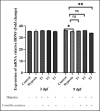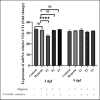Centella asiatica extract ameliorates deoxygenation-induced neurological dysfunction in zebrafish larvae
- PMID: 38938421
- PMCID: PMC11199753
- DOI: 10.5455/OVJ.2024.v14.i5.9
Centella asiatica extract ameliorates deoxygenation-induced neurological dysfunction in zebrafish larvae
Abstract
Background: Oxygen deprivation (OD) is a critical condition that can lead to brain damage and even death. Current hypoxia management approaches are limited in effectiveness. Centella asiatica (CA), known for its neuroprotective properties, offers a potential alternative for OD treatment.
Aims: This study aims to investigate the neuroprotective effects of CA on the expression of brain-derived neurotrophic factor (BDNF) and vesicular glutamate transporter 1 (VGLUT1) in zebrafish larvae under oxygen-deficient conditions.
Methods: Zebrafish embryos were subjected to low oxygen levels (1.5 mg/l) 0-2 hours post-fertilization (hpf) until 3 days post-fertilization (dpf), simulating the early stages of OD. Subsequent treatment involved varying concentrations of CA (1.25-5 µg/ml) up to 9 days post-fertilization. The expression levels of BDNF and VGLUT1 were measured using PCR methods. Statistical analysis was conducted using a two-way analysis of variance to evaluate the impact of CA on the expression of BDNF and VGLUT1 in zebrafish larvae aged 3 and 9 dpf in oxygen-deprived conditions.
Results: CA significantly influenced the expression of BDNF and VGLUT1 under OD (p < 0.001). An increase in BDNF expression (p < 0.001) and a decrease in VGLUT1 (p < 0.01) were observed in zebrafish larvae experiencing OD and treated with CA. There was no significant difference in BDNF and VGLUT1 expression across age variations in zebrafish larvae at 3 dpf and 9 dpf in the treatment groups (p > 0.05). CA concentration of 2.5 µg/ml effectively enhanced BDNF and reduced VGLUT1 in 3-9 dpf zebrafish larvae.
Conclusion: CA demonstrates potential as a neuroprotective agent, modulating increased BDNF expression and reduced VGLUT1 under OD conditions. These findings lay a foundation for further research in developing therapies for oxygen deficiency.
Keywords: Centella asiatica; Neuroplasticity; Neuroprotective; Neurotoxicity.
Conflict of interest statement
The authors declare that there is no conflict of interest.
Figures


Similar articles
-
Centella asiatica Prevents Increase of Hippocampal Tumor Necrosis Factor-α Independently of Its Effect on Brain-Derived Neurotrophic Factor in Rat Model of Chronic Stress.Biomed Res Int. 2019 Mar 6;2019:2649281. doi: 10.1155/2019/2649281. eCollection 2019. Biomed Res Int. 2019. PMID: 30956976 Free PMC article.
-
Asiatic acid increased locomotor and head width by inducing brain-derived neurotrophic factor in intrauterine hypoxia-exposed zebrafish.Open Vet J. 2023 Oct;13(10):1326-1333. doi: 10.5455/OVJ.2023.v13.i10.12. Epub 2023 Oct 31. Open Vet J. 2023. PMID: 38027402 Free PMC article.
-
Intermittent fasting along with hydroalcoholic extract of Centella-asiatica ameliorates sub-acute hypoxia-induced ischemic stroke in adult zebrafish.Comp Biochem Physiol C Toxicol Pharmacol. 2024 May;279:109871. doi: 10.1016/j.cbpc.2024.109871. Epub 2024 Feb 29. Comp Biochem Physiol C Toxicol Pharmacol. 2024. PMID: 38428624
-
Centella asiatica in dermatology: an overview.Phytother Res. 2014 Aug;28(8):1117-24. doi: 10.1002/ptr.5110. Epub 2014 Jan 7. Phytother Res. 2014. PMID: 24399761 Review.
-
Cardiovascular Protective Effects of Centella asiatica and Its Triterpenes: A Review.Planta Med. 2019 Nov;85(16):1203-1215. doi: 10.1055/a-1008-6138. Epub 2019 Sep 20. Planta Med. 2019. PMID: 31539918 Review.
Cited by
-
Plants' Impact on the Human Brain-Exploring the Neuroprotective and Neurotoxic Potential of Plants.Pharmaceuticals (Basel). 2024 Oct 7;17(10):1339. doi: 10.3390/ph17101339. Pharmaceuticals (Basel). 2024. PMID: 39458980 Free PMC article. Review.
References
-
- Ariani A., Ghofar I., Khotimah H., Nurdiana N., Rahayu M. Asiatic acid in Centella asiatica extract towards morphological development in an intermittent hypoxia intrauterine embryo model and molecular prediction pathway of insulin-like growth factor-1 (IGF-1) receptor signalling. Open Vet. J. 2023a;13(5):629. - PMC - PubMed
-
- Barrionuevo W., Fernandes M., Rocha O. Aerobic and anaerobic metabolism for the zebrafish, Danio rerio, reared under normoxic and hypoxic conditions and exposed to acute hypoxia during development. Braz. J. Biol. 2010;70(2):425–434. - PubMed
MeSH terms
Substances
LinkOut - more resources
Full Text Sources
Molecular Biology Databases
